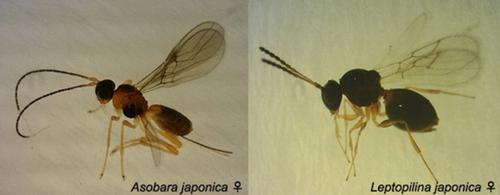当前位置:
X-MOL 学术
›
Entomol. Sci.
›
论文详情
Our official English website, www.x-mol.net, welcomes your
feedback! (Note: you will need to create a separate account there.)
Drosophila parasitoids ( H ymenoptera) of J apan
Entomological Science ( IF 0.7 ) Pub Date : 2020-09-07 , DOI: 10.1111/ens.12432 Masahito T. Kimura 1 , Hideyuki Mitsui 2
Entomological Science ( IF 0.7 ) Pub Date : 2020-09-07 , DOI: 10.1111/ens.12432 Masahito T. Kimura 1 , Hideyuki Mitsui 2
Affiliation

|
The Drosophila parasitoid system is an excellent model for the study of biological and ecological interactions. In Japan, extensive studies have been carried out on Drosophila parasitoids since the early 2000s. Here we provide up‐to‐date information on their diversity, distributions, host use and reproductive mode. Until now, 45 wasp species have been recorded. In addition, four genetically distinct groups (tentatively assigned as “races”) have been found in Ganaspis brasiliensis (Figitidae). Most of them are larvo‐pupal parasitoids belonging to the families Figitidae and Braconidae, and some are pupal parasitoids of the families Pteromalidae and Diapriidae. A species of Encyrtidae was also recorded. Their major hosts are indicated with information on the host's breeding sites. Except Ganaspis xanthopoda and two races of G. brasiliensis that are distributed both in tropical and temperate regions, they are divided into tropical and temperate species. The tropical species are mainly distributed in Southeast Asia, and their distributions in Japan are restricted to the Ryukyu islands, particularly Iriomote‐jima. The temperate species have been recorded from the main islands of Japan and surrounding islands but not from the Ryukyu islands, except two braconid species, Asobara japonica and Phaenocarpa sp. TK1. Some of the temperate species have also been recorded from Korea, China, Europe and/or North America. Among the 45 Japanese parasitoid species, at least seven are assumed to be thelytokous.
更新日期:2020-09-07











































 京公网安备 11010802027423号
京公网安备 11010802027423号